#Alaskan surplus
Explore tagged Tumblr posts
Text
Discarded, Disposable Dolls have a unique talent for finding missing parts.
Fallen loose screws, whole sections of plastic edging, missing metal rods of larger contraptions. If it can fall off a machine, it will find it's way to such dolls.
It is useful to keep this type around in industrial environments, even with their fragility. They can and will find important parts for repairs without any interruption to their assigned duties. The sheer volume of missing pieces they find and bring to their superiors that go unnoticed by human coworkers can be staggering!
It is likely because discarded, disposable dolls are prone to feeling a sense of kinship with these sorts of things. A silly notion, but they feel naturally drawn to collecting them in hopes of granting them the new purpose they themselves so desperately crave.
But be forewarned, such dolls are also known to exact great satisfaction from repairing and maintaining simple devices with hand tools. Which, while very helpful, will often mean you may find a stash of such lost bits and bobs in the dolls things. They are selective with the pieces they keep for themselves, collecting only items they know they can utilize in an incomplete repair or for use in resolving a common problem, but these are still parts they have taken.
It is up to individual discretion if you punish this behavior, as the doll will find it distressing to have the parts taken before they can be put to use. But, they are just a doll, after all, and a broken one at that. How much weight should you really put in the feelings of a broken tool, overdue for disposal?
72 notes
·
View notes
Text
Occasionally day dream about the idea of running a homebrew TTRPG in Følslava but always have to reality check myself with the facts that
A) The players could not play as the absolute coolest shit in the setting without breaking the entire game over their knees instantly. like no, I'm sorry, I know being an android girl is like your entire gender identity but you cannot play a Combat Amary because unfortunately that'd mean you're playing DMC/Ultrakill while everyone else is still playing callerdoody. No, i will not nerf them to make them playable. Them being insanely overpowered Is the point.
2) It'd be impossible to surprise anyone with the whackier shit in the setting as a mystery since I've already shared what exists in universe with the people who would theoretically play it. I can't make a mystery that reveals [REDACTED] because everyone in my friend group is aware of [DATA EXPUNGED] already.
5 notes
·
View notes
Text
I KICKED HUEY IN THE DICK UNTIL HE DIED??????????
9K notes
·
View notes
Text
No. 51 - Alaska Airlines

This is one of my most requested posts. Apparently, a very significant portion of my readers fly Alaska Airlines!
That tracks. Alaska Airlines is the fifth largest airline in the US. A sort of anti-Flair, they are supposedly the least complained-about full-service carrier in the US. They are also one of five remaining US legacy carriers, along with American Airlines, Delta Air Lines, Hawaiian Airlines, and United Airlines. They operate a massive network primarily on the US West Coast, with bits branching out into nearby slices of the Americas. As one might surmise from prior knowledge of the size and population of Alaska, they're actually mostly based in Seattle.
Now, when it comes to their livery, there's one thing that stands out. At least, it stood out to me, and I'm sure at least some of you have had this thought too.
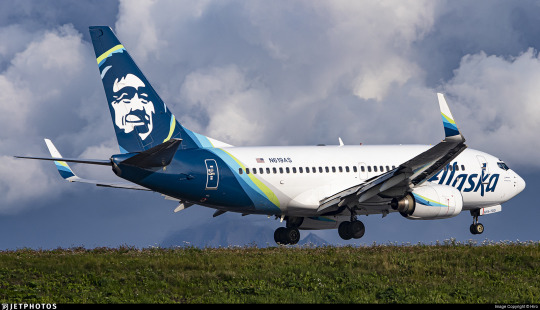
That is a human person's face on the tailfin. But who does that face belong to, and why is it on the Alaska Airlines fleet? This is precisely the sort of trivia I think anyone who knows me would expect me to be able to just rattle off, but actually...I don't know, and neither, as far as I can tell, does anyone else. Isn't that weird?
(By the way, it is indeed Alaska Airlines. I have always found that somewhat unintuitive. It's just not how you're used to hearing things phrased, right? It's Possessive Noun Airlines, Air Noun. America Airlines would sound weird. Alaska Airlines sounds weird. I am never surprised when people mistakenly say Alaskan Airlines, but it's Alaska Airlines. Just so we're all on the same page.)
Alaska's a bit of a hard place to navigate. Big empty place, lots of ice, lots of mountains, islands, trees...not very much asphalt. That's even true now, but it used to be way truer, and even back then people did still live there. And there's a lot of things those people might maybe like to have, like medical care, or food, or just the hypothetical possibility of getting somewhere without having to get the snowshoes out. In that sense, Alaska is a really perfect place for aviation to flourish.
More or less as early as physically possible, when there were planes available that weren't requisitioned for the first World War or owned by the ultra-rich, people were flying in Alaska. In a lot of ways the basic landscape hasn't changed that much. With its surplus of difficult environments and paucity of actual tarmac Alaska's harsh wilderness is an environment only suited for "bush" flying, using smaller, more rugged airplanes specialized for the environment. Some of the most popular models of bush plane are very old, not that dissimilar to what you'd see in the 50s and 60s - apparently, they just don't make them the same anymore, and as long as you don't get your de Havilland Beaver crunched horribly into the side of a mountain there's just nothing that can replace it. Alaska is full of planes on floats, planes on skis, and taildraggers on tundra tires, most of them high-wing and piston-engined. Bush pilots are a unique sort, often doing work that's neither glamorous nor lucrative (nor safe, with Alaska having two to five times the accident rate of the lower 48) but undeniably necessary.
That's not as true of Alaska Airlines. They have a modern fleet, a good safety record except for that one time, and as a category III carrier they make over a billion dollars in revenue each fiscal year, meaning their finances aren't too strained (except for that one time). Unlike the local carriers that connect remote parts of Alaska to resources and to major cities, Alaska Airlines connects Alaska to the rest of the nearby world. (Though it also does short, multi-stop milk run flights.) It's a necessary part of the ecosystem, helping to keep Alaska's beautiful but hostile terrain from getting in the way of daily life. Before they became Alaska Airlines, though, they were far more similar to what you might expect of...Alaska airlines.
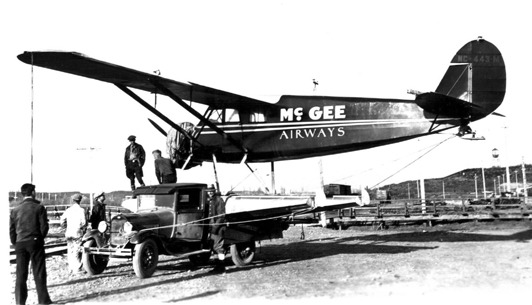
Image: Roy S. Dickson
In 1932, a man with the fantastic name 'Linious McGee' started his very own airline. You could just do that back then. In 1934 it was merged into Star Air Service, another tiny airline. Star Air Service had also been founded in 1932, born from the flight-school-starting dreams of a wealthy miner with the similarly wonderful name 'Wesley Earl Dunkle'. Apparently Star had its first ever aircraft, a Fleet B-5 biplane, brought to Alaska by steamship, which I just find fairly interesting. I guess this was before you could even ferry an airplane directly to Alaska by air. They ate up a few other small airlines (and their routes), and in 1943 they won a small scuffle against another pretender to formerly rebrand themselves as Alaska Airlines. So it's been 80 years of that now!
They've gone from flying Curtiss Robins, Ford Trimotors, and Lockheed Vegas to flying basically only 737s, save a few vestigial A320 family aircraft acquired when merging with Virgin America which they plan to phase out by the end of 2024. Their livery is also on E175 regional jets operated by Horizon Air and SkyWest. The airplanes flying for them number around 300. That's incredibly large even by the standards of major airlines (not even counting the SkyWest planes that have the livery).

The Alaska Airlines livery is not breaking any molds and I need to say that upfront. This is a very straightforward pattern I've taken to calling the Lufthansa Declined, or the Lufthansa Line SAS Variation. (Because the push and pull of trend cycles in brand identity is basically comparable to chess, right? Maybe? No? Not really?) I've recently codified the concept of the Lufthansa Line, the straight line continuing where the tailfin left off to carve through the fuselage. This is a very common and very disappointing fuselage trope. The Declined, or SAS Variation, is named for an airline I specifically contrasted with Lufthansa from my very first post on this blog, SAS.
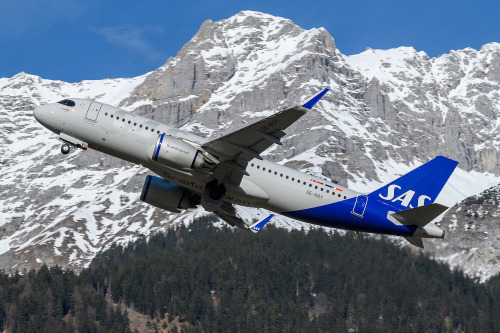
The SAS Variation simply curves this line outwards towards the front of the plane, stopping the cutoff from being quite so blunt and hopefully undoing the unbalancing effect somewhat. This can solve some of the nastier effects of Lufthansa Lines, particularly on shorter planes, but can also look very wonky if implemented without enough care. It's not always a big improvement, but it's definitely not the exact same thing, either, and it's this shape which Alaska Airlines attempts. Being introduced in 2016, this livery actually pre-dates SAS, but Delta and Lufthansa weren't starting their own namesake patterns either. The names aren't attributed based on innovation, but on formative status in my own specific understanding of airline liveries. SAS as contrasted to Lufthansa is the holotype for my creation of the taxon, and thus earlier liveries are retroactively SASlikes. Birds are dinosaurs and whales are ungulates. Taxonomy is imperfect and has to accommodate new discoveries within a sometimes unintuitive framework. That's just how it is.
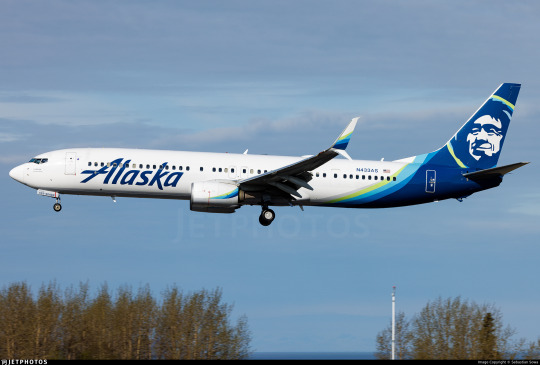
I think they do better than many. The fact that they use so many colors, layered over each other, is crucial to the effect. It accomplishes similar things as a gradient might, transitioning from dark to light with minimal pain in the process.

Image taken from Alaska Airlines's very useful branding style guide.

The shades of blue and green used resemble the Aurora Borealis. I can't find anything confirming that this is intentional but I can't imagine it isn't. I think they're very nicely chosen. Different lightings can make the blue (Alaska's material calls it midnight blue, but it's technically Prussian blue) look anywhere from true vivid blue to more of a deep ocean color, which is one of my favorite shades. In particular, the very washed out yellowish green is an absolutely gorgeous choice for a highlight color. I like that the colors aren't given equal purchase, though, and that the green is used sparingly for highlight, and to create that lovely subtle 'halo' around the face on the tail. Sometimes less is more, and this is one of those cases. In fact, their own website states:
Midnight is our primary brand color, and should be used sparingly to avoid overuse—giving more prominence to the Alaska Airlines brand.
(They also note that they took specific efforts in the design process to make sure these colors had significant contrast between them to meet accessibility standards, which I really appreciate and want to see more of.)
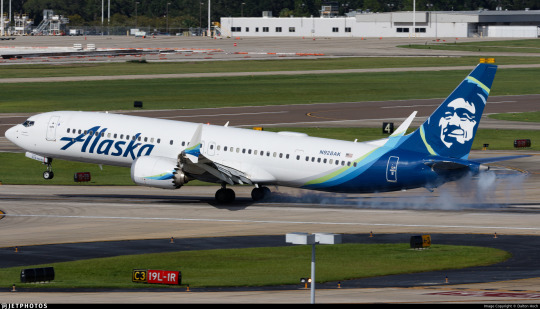
For example, if the 'intermediate' blue colors took up more of the plane, or were separate from the green, I would probably not feel any real way about them. I definitely wouldn't think they were nice if they just did a standard Lufthansa Line block with each color individually expressed. But using them as a trim to a nice clear deep blue, overlapping each other in a way that's very carefully mapped out but seems at a glance essentially random, halfway to mixing, like the dark tail is melting slowly into the fuselage...that's nice. That adds something.

The partially-overlapping, brushlike curves are further expressed as swashes on the winglets and engines. What's interesting to me is that if you look closer you can see that the little curves are on both the inboard and outboard sides of each engine and winglet, so you get that consistent curve, hypothetically, no matter what angle you see it from. I do think I appreciate that. The curves are just never going to all line up, because airplanes are inconveniently three-dimensional and there are as many angles to view them from as there are Planck lengths at a distance where you can tell what it is you're seeing. This is a weakness in all liveries more detailed than a Braniff jellybean and adding the curves to even the side of the engine that you're usually not going to see is definitely an appreciated attempt to mitigate this. Does it work? Maybe not totally, but I see the effort.

While there's never a perfect syzygy into one continuous line, the curves seem like they're part of the same nebulous body from most angles. I appreciate this approach. I think making things look pretty good from most angles is worth more than making things look really good from one angle and awkward from all others. As they say, the perfect is the enemy of the good. I absolutely love the use on just the inside middle of the scimitar winglet, which I already think is a gorgeous feature that just elevates the MAX and retrofitted 737NGs compared to the vanilla model. It's distinctive and stylish, and the limiting of the color to just the lower half of the upper blade has a real restrained elegance to it - these slashes of color are all the more effective for the way they interact with the space around them.

Just look at these winglets. They're such a tiny feature. It's absolutely wild that I can be this in love with winglets, but there's just something about split scimitar wingtips that make me go completely wild. The amount of space and the interesting shape leaves so much more room for creativity than just about any other wingtip device. Alaska Airlines does have planes with other wingtip styles, and it uses those effectively too - covering the lower half of canted/blended winglets and fully encompassing the interior of less pronounced split winglets - but this is where they look their best.
Back to bad angles, though...


Alaska Airlines has a weird weak spot, and it's from the front and slightly above. All those gorgeous swoops on the winglets and nacelles are basically impossible to see due to their two-dimensional nature, and you can see how the colors don't fully cover the back of the fuselage. My normal policy is to judge liveries by their weakest link, but I honestly almost want to be lenient on this because of how unlikely it is that you're ever going to see an airplane from this angle. The only situations you're ever above an airplane in are ones you're basically never going to encounter as a regular passenger. Don't get me wrong, I still think this could have been designed in a way which eliminates this weak point, but as far as weak points go this is quite excusable. Is that what Thetis thought when she dipped her son in the Styx? Sure, probably, but I stand by my take. For a lot of liveries their worst angle is close to side-on, which is just fully experience-ruining. This? I'm okay with this, relatively speaking.

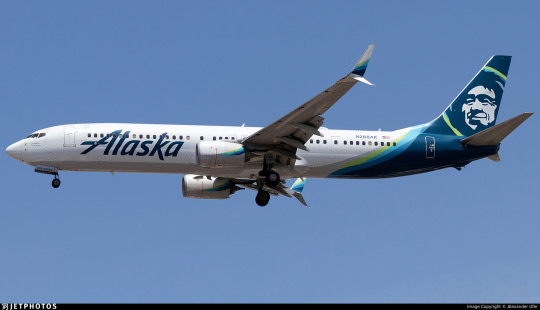
On the other hand, one of the better angles is one a lot more people will see - below and to one side. The taper of the different bands of color really prevents the awful jarring cutoff that Lufthansa Line and SAS Variation liveries often have, and I feel like they trick the eye into thinking up more of the fuselage is occupied than it really is. Also worth noting is that the grey underside, which resembles a shadow, is actually intentionally painted on, which is lovely. This is a feature common to the Deltalike livery trend that I outline at the start of my Southwest post, which I do think is one of the things that makes me honestly a bit sympathetic to Deltalikes when looking at them next to Lufthansalikes - at least there's an attempt to distribute visual detail evenly. Deltalikes were already a bit dated by 2016 (it was not the longest-lived trend, though it came at a time in my life perfectly positioned to make me think it was more prominent than it was) while SASlikes were on the rise, and this livery has aspects of each, but it feels less like a conflicted result of an intermediate period in dominant trends and more like something which intentionally pulled features from both where it thought they might work best. It's rare that I get this sense from a livery. That's the right way to use trends - as inspiration, not a template.

Alaska Airlines is definitely not a true Deltalike, and I would argue it's not a true SAS Variation either. (For the record, I would consider the 1998 SAS livery a Deltalike, funnily enough!) It incorporates features of both, which makes me feel uncomfortable classifying it definitively as either, though it's definitely more of a SASlike than not. For example, from the side it just is a SASlike, because the grey doesn't go high enough and isn't contrasting enough to be visible except from below. This is in contrast to actual Deltalikes, which have a thin but clearly visible line on the lower side where the underside's block of color bleeds out.
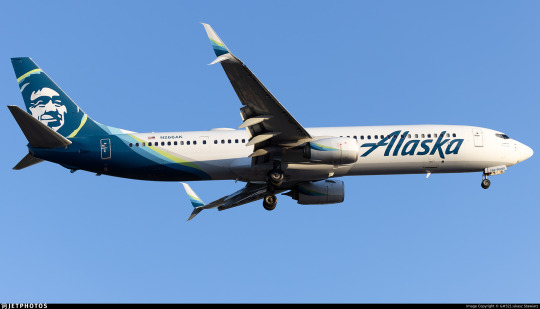

This grey color is also on the engine nacelles, although it is very subtle. This does bring up a minor gripe of mine, which is that the design on the pods cuts off at a bit of an awkwardly sharp angle, usually not worth remarking on but possible to notice from some angles if you are, say, a livery reviewer and you look at these things very closely. What I do like, though, is that the grey on the belly actively connects to the color on the tail, feeling like an extension of it instead of an awkward choice made to mitigate it.
The final specific feature of the livery I think I want to comment on is the wordmark. I really like the wordmark. It's not in their custom typeface, AS Circular, a Roboto-ish sans serif I'm not a gigantic fan of, although I really like their custom web icons. They also use Highest Praise by Adam Ladd, a fairly cheap commercially available font.

As for the wordmark itself, though, I can't seem to find what font it's based on! I have to say the original 1966 logo would be great if another airline were to use it, the 1972 is somehow giving supermarket chain, and the 1990 logo would be great if not for the weird way the K overlaps the A, which just feels sloppy and unprofessional. The 2014 and 2016 incarnations, though, are great. The 2016 one (designed by the firm Hornall Anderson) feels like a great update, just cleaning up the earlier version, though I somewhat miss the lightning-bolt S.


The placement is what I want to talk about, though. Placing a wordmark is more of an art than you might think - I'll show a couple examples of Alaska itself doing a slightly wonky job later - but when Alaska's placement is good it's great. It's one of the least cramped-looking wordmarks I've ever seen, feeling free and airy, spreading upwards above the window line. The descending line on the K and the trailing like on the A both create a feeling of freedom, like it could just keep going but doesn't want to, yet is tastefully restrained and doesn't actually overstep its bounds. I like the solid single color, and I like that it reaches almost to the engines, preventing that empty-forward-half feeling. The one thing I'll comment on for this set of images is that the left-to-right reading direction of English does mean that it looks distinctly worse seen from one side than the other. I much prefer the forward slant, which feels aerodynamic fitting with the motion of the plane, vs the alternative, in which it feels like the wordmark is trying to catch up with the aircraft's nose.
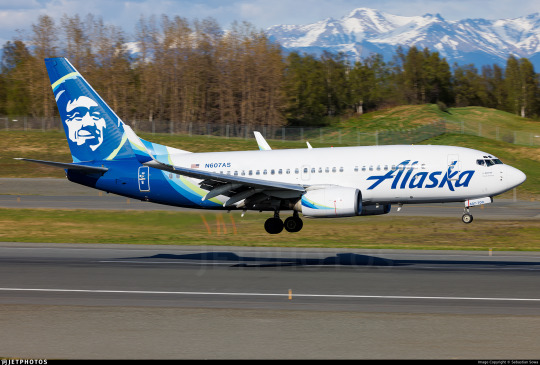
On shorter planes, though, Alaska fumbles a little. They choose to line up the wordmark with the engines instead of with the nose, creating an awkward look when it overlaps the door and nearly reaches the cockpit window. I would have leaned in the other direction were I them. This picture also demonstrates a strange feature which rears its head in certain lightings where the shading on the tailfin image makes it look almost wrinkled. I don't have anything to add to that or know how to solve it, but I need to point it out.
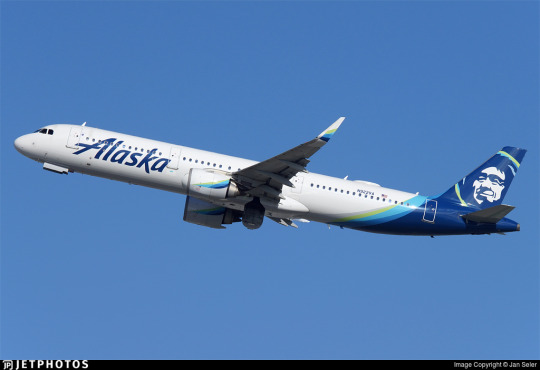
On a very long plane, conversely, the back half of Alaska's planes begins to feel that Lufthansa Line emptiness. The vast, vast majority of their planes are of a moderate enough length that neither issue is too overpowering, but I'm taking a wide view here! Also, the wordmark here seems to not be aligned with the engines, so...what's the idea?

Alaska Airlines is an interesting livery. More interesting than I thought I'd find it for sure. It's not just a SASlike with pleasing colors and a nice wordmark, it's a SASlike with thought put into features that can mitigate the inherent weaknesses of the SASlike. It doesn't always fully succeed, nor does it comprehensively fail, but it definitely tries.
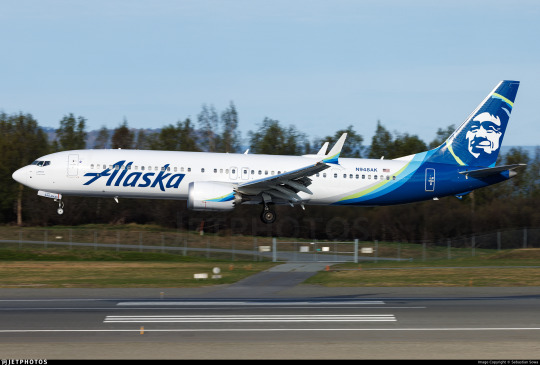
At the end of the day, as usual, I wish there was less white. I'm sure it could have been done. I don't have an obvious solution in mind like I do for some hypothetical redesigns, so it's something I would have to think over and really dig into, but, like, Alaska Airlines makes more than a billion in revenue every year so I think that's reasonable to expect from them.
I initially started using the grading system as a way to categorize liveries without limiting myself to a very specific scale that I'll dither about for years and then change my mind about later, but it's started to end up in that role. I just don't know what better solution there is, so I'm going to continue trying to make it work. Alaska Airlines is a livery that I ultimately think I like, that I think is designed decently, but that is limited by the fact that a really good SASlike is still a SASlike - mostly white and rear-heavy. It's getting the most possible out of a flawed paradigm, and I've been inconsistent so far on how I rate a good SASlike or Lufthansalike because it causes me some legitimate cognitive dissonance.
I'm giving Alaska Airlines a provisional B-.
I think I might downgrade it to C+ later, which is why I say it's provisional. A good execution of something really limited - how do I even rate that? It's somewhere between tepidly good and better-than-average, which is a really awkward place to be. But that's probably a conversation for another day, because this post is long enough and I'm still not done.
Okay, I teased this earlier.

Him. Who is he?

The short answer: nobody knows. Not me, and not Alaska Airlines.
The long answer: deserves its own post. Both because it's long, and because I've hit image limit. And there will be images. Join me in tomorrow's bonus, where we climb our way through the rugged terrain of seemingly-lost history to attempt to put a name to this ubiquitous face.

#tarmac fashion week#grade: b-#era: 2010s#era: 2020s#region: north america#region: united states#alaska airlines#legacy carriers#lufthansa declined#deltalike#skywriting
51 notes
·
View notes
Text

airsLLides No. 4880: N9744C, Lockheed L-188PF Electra, Reeve Aleutian Airways, Anchorage, July 8, 1990.
Reeve Aleutian was also among these iconic Alaskan airlines that helped shape the airline industry of the State, but ultimately lost their once seemingly untouchable market niche. In 1946, Robert 'Bob' Reeve began running charters for the shipping industry as well as intra-Alaskan flights to remote settlements with an initial fleet of four Douglas DC-3 purchased from surplus military stock.
In 1947, the venture was incorporated under the Reeve Aleutian name, and traffic rights to various destinations on the Alaskan mainland as well as on the island chain of the Aleutians were awarded to the young airline. Flights from its base at Anchorage Ted Stephens airport to the Aleutians, e.g. to Adak, Atka, Cold Harbour, Dutch Harbour, Shemya Island or St. Paul, as well as on the mainland such as to King Salmon or Kodiak, remained the core of the airline's business for decades.
In the 1990s, Reeve Aleutian operated a pretty unique fleet of Japanese-built NAMC YS-11 twins in passenger configuration, alongside Lockheed L-188 Electra turboprops and Boeing 727-100 jets used as 'combis' in a mixed passenger/cargo layout. That configuration is clearly visible on N9744C, with the window-less front half of the cabin used for airfreight and the rear section - traditionally the quieter part of a prop - fitted with a passenger cabin accessible through the door aft of the wing.
Citing increasing competition from Alaska's main carrier and rising fuel and maintenance cost, Reeve went out ot business in December 2000, leaving a gap in scheduled combined pax/cargo services to secondary destinations on the Aleutian Islands. By then, its active fleet had already shrunk to just one Electra and one 727, both of which flew one to two round-trips a day to the Aleutians.
1 note
·
View note
Text
Watching old episode of John Oliver talk about Alaskan town having a bet on when a tri-pod on the melting ice falls to the river, and all I can think about is that someone needs to tell them about Finland's "how many people will drown this midsummer" bingo army surplus store does.

This is one of the rules.
8K notes
·
View notes
Text

I own one of this sort of rug.





Afghan rugs
#alaskan surplus#bad picture from when i got it but im at work and will forget by the time i get home#i regret not getting a 9/11 one too but the importer wanted a $100 plus per so-#i think the one thats most like#damning#is the rug i saw that was just silhouettes of the underside of drones.
1K notes
·
View notes
Text
There's a blade i carry with me. A sword. A greatsword. It never leaves me.
It's heavy and far larger than me, some days i crumble under it's weight yet I could not drop it even if I wanted too.
It's intricately beautiful. Masterfully smithed.
I'm holding it right now, can you see it?
Can't you see it?
All the people who matter to me have their own swords, each one is as unique and beautiful as the last. For some it's much lighter than others.
I carry it with me everywhere i go, it can be seen before even i am seen yet some people never see it.
Some people see it, but choose to pretend they don't.
Tell me you can see it.
20 notes
·
View notes
Text

SAM REF 3: THE THREEQUEL.
This started as a straightforward redo of her previous ref that was meant to just serve to establish a consistent idea of her exact body shape (she'd been trending towards a larger belly entirely because the original ref didn't have a good non straight on angle of it.) and establish some extra outfits.
Naturally some design minor tweaks and extra details snuck there way in there too...and then the hair happened.
Basically, i looked at the original Sam design again in some art that had been drawn by a good friend years and years ago that had only been abandoned because i lacked the artistic skill to draw a side shave consistently. I realized as i was looking at it again that that version of Sam was still the one that i pictured in my head. The hair vents thing had never managed to truly stick within in the mind palace. It was too generic, at least for Sam.
So, fuck it, i brought back the original hair on the new body and face design and then merged in the main element of the ponytail braid i did like, that being the bang between the eyes.
AND VOILA, here we are. this one was kind of an ordeal for a variety of factors with multiple redraws. I am ultimately happy with it, at least. I experimented a lot with blending in colors for skin and hair tones and then threw on both a tonal and color correction layer on top for the hell of it. That last part may not have been the best decision given i had had rum and sleeping pills in the course of painting this...oh well!!
#digital art#artists on tumblr#fat art#fat girl#character reference#oc: Sam#setting: 931#alaskan surplus
5 notes
·
View notes
Note
About your seruggofelees post, wanna tell some headcannons? I'm interested
ANON I'M SMOOCHING YOU ON THE FOREHEAD RN THANK YOU
okay, Human AU with Alive!Sera:
Once Sera's healed up and back home with baby Hestia, she, Mistoffelees, and Tugger have a very serious talk about their future. They agree to spend a few months actually dating and being in a relationship, making sure that they are all serious about being together romantically.
They go on dates to Browrey's bar, picnics, and just all sorts of fun things that they all absolutely love. They also have a surplus of babysitters, so spontaneous dates are not an issue!
Family outings are also very much a thing, because Tugger and Mistoffelees want to make absolutely sure that the kids are okay with the new dynamics. They don't have to worry, though, because Hades and the triplets started calling Tugger and Misto "dad and "papa" even before Hestia was born.
The proposal is something very quiet and simple. It's during one of the weekly family dinners, where everyone's gathered together at Munkustrap and Demeter's house, and Serafina has a feeling of what's going to happen, especially when all the kids come up to her handing her a rose, and Tugger and Mistoffelees come out, and she's already crying. It's the sweetest thing, and Demeter obviously recorded every single minute of it.
Serafina's bridesmaids for their wedding were Bombalurina, Browrey, Victoria, and Jellylorum, and her maid of honor was Demeter.
Post-Wedding, Tugger and Mistoffelees immediately sign the adoption papers for Hades, the triplets, and Hestia, making them all officially a family.
They're the people who have an Alaskan King bed, because they want room to be able to cuddle without someone falling off, and it's a regular occurrence to wake up to either Hades or the triplets curled up on the bed.
They are SO sappy, it's ridiculous.
Seriously, Tugger walks up behind either Serafina or Mistoffelees, and will wrap his arms around them and twirl them around. Mistoffelees will absolutely pull one of his partners into an impromptu dance, especially if he's working on a new number for one of his recitals. Serafina is very physically affectionate, like Tugger, so she'll kiss their cheeks, hold onto their hands, or just hug them at random points during the day.
PET NAMES FOR EVERYONE SO MANY ADORABLE PET NAMES
my love, darling, sweetheart, gorgeous, my queen, handsome, babes, beauty, literally SO MANY
Being a triad means it's so easy to take care of their five kids, Hestia's always in someone's arms, the triplets treat their dads like jungle gyms, and Hades is nearly always climbing onto someone's back or shoulders.
They do movie nights at least once a week, and it's one of the reasons they get a massive bed, because all the kids just pile on top of them and they all cuddle up for the night, and that's usually when the kids fall asleep in their parents' bed.
Serafina returns to teaching dance after she marries Tugger and Mistoffelees, something she stopped after getting pregnant with Hades, and she and Mistoffelees have at least one dance together whenever the studio does a rehearsal.
Tugger and Serafina play music together at least once a week, he plays the guitar and she plays the fiddle, and Mistoffelees either sings or dances with the kids!!!
@queen-with-the-quill now I'm thinking about Serafina being around when they find Jubilee and being the best mama to her 🥺
#sobbing i love them more than anything#anon you're the LOVELIEST#ty for asking about my ot3#cats the musical#mr mistoffelees#rum tum tugger#serafina the tragic queen#seruggoffelees#tuggoffelees family human au
13 notes
·
View notes
Text
Daily.
Trans girls should get $6000 for existing
6K notes
·
View notes
Text

Good evening everyone! I have been researching the last few weeks on how to reuse the trees on our homestead that we have been cutting down to make room for all the fun projects. We have been running through ideas like making an Alaskan saw mill or turning the trees into fence which are all great ideas and will eventually be done. But those will not cover all the trees we will be taking down. What I have pictured is known as a hugelkultur bed. This style of garden uses the trees and stick debris mixed in with leaves compost and dirt to create a 20 year surplus of constant fertilizer for your plants that you will not have to water often due to the trees retaining water. This will benefit our homestead garden and will allow for a semi set it and forget it style garden. Well to a degree at least. You will still need to cull and maintain the standard garden up keep however the soil will not need as much work with nutrients being replenished due to the rotting wood and compost. Also less watering unless you are in a drout.
#sustainable#sustainability#organic farming#farmers#covidー19#fresh from the garden#fresh fruit#fresh veggies#fresh vegetables#reduce reuse recycle#reusedmaterials#creative reuse#reuseable
1 note
·
View note
Text
Airline Travel With a Stroller
Airline travel can be a very exhausting, confusing, and also exasperating experience nowadays. With regulations and rules on what it is that you're permitted to bring on board altering everyday, and each airline placing their own twist on the principles, it may not be possible to understand what you can and can not do.
Traveling with a baby or toddler leaves flying around 100 times harder, it sounds. So many parents decide to browse the highways that are busy with the assistance of a stroller. Traveling using a stroller can surely make things simpler, however once you book your next excursion, we have compiled a listing of particular rules and regulations concerning the transport of your infant's stroller throughout your trip.
Most airlines believe that a stroller for a part of luggage which, thankfully, isn't subject to some extra luggage fees. To put it differently, you'll have your routine carry-on and private item exactly like everybody, and deliver the stroller as an added bit without a charge. Most motorists do require that you simply assess the stroller till it could fit under your seat or in the aisles. But because most strollers don't fit in these areas, gate assessing is the thing to do. Some airlines have limitations on the magnitude of their stroller. Most recommend or even require your stroller function as a little umbrella stroller. Hawaiian Airlines especially does not permit strollers. Other airlines don't have a particular rule for this, so that will mean it's available for interpretation. If you anticipate bringing a running stroller or other big stroller, then you might choose to phone the airline before you travel to ask if it's OK to do so.
Here's a listing of many airlines and their particular regulations which we have compiled according to which was printed on the official airline sites on September 9, 2009. Please bear in mind that these regulations can change at any moment, so until you travel make sure to double check with your airline to be certain that the very same principles apply. Not all drivers were unique in spelling out their principles about strollers, therefore we've set what we could discover. For more thorough info, contact the airlines directly.

Air Canada: One stroller has been assessed in at the gate, along with 2 pieces of checked luggage compartment.
Air France: Children under the age of two are eligible for a special allowance of 10kg and one cabin luggage thing, also one of these things: cushioned stroller, bassinet, or car seat.
Alaskan Airlines: Strollers and car seats might be assessed with no charge.
Allegiant: Each fare-paying passenger is permitted to have a stroller or car seat into the boarding place. The stroller or car seat may also be assessed in the time of check-in. In case the stroller or car seat is carried to the gate, then it'll be gate checked.
American: You can continue one bag and one personal item per passenger. You might also make an umbrella stroller to get a motorbike or ticketed kid along with both carry-on products.
British Airways: One completely collapsible stroller is permitted.
Continental: Continental takes one particular stroller as well as a client's luggage allowance. When checked as luggage, all oversize and overweight fees will apply. First and second tote fees not to use to a stroller or car seat. Continental isn't responsible for harm to scooters. Surplus Valuation might not be bought for scooters. If you're traveling with a stroller and a car chair along with the baggage allowance, then just one of those items is completed at no cost.
Delta: Strollers will be assessed at no cost and aren't counted as part of their normal luggage allowance. Strollers might be assessed at curbsidethe ticket counter, or even in the gate.
Direct Air: Strollers could possibly be approved as Gate Check things, if needed, subject to the Standard Baggage Service Fee and depended on an passenger's allotment of 2 assessed items.
Frontier: Strollers have to be gate checked.
Hawaiian Airlines: First and instant assessed bag fees don't apply to scooters with the exclusion of running or massive strollers. You might check on your desk at the gate or in the check counter for free if accompanied by a ticketed adult passenger. Running strollers aren't allowed for gate identification.
JetBlue: A bicycle baby may bring 1 diaper bag, 1 stroller, and a single car seat. Babies which are jetting free of don't be eligible for the checked luggage allowance. Strollers are regarded as a"special item" that can be performed for free along with a regular carry-on product. It might go on board whether it is going to fit in the overhead or below the chair, otherwise it has to be gate checked.
KLM: A little, fully collapsible stroller could possibly be carried into the cottage. It needs to be in a position to fit in the overhead compartment or under the chair facing you. A stroller may always be assessed in as check bags at no additional charge.
Midwest Airlines: Strollers aren't subject to some extra luggage fees.
Northwest: One completely collapsible umbrella-style stroller could possibly be performed on board along with the carry-on luggage allowance. Strollers might be performed on board whenever space is available. Otherwise they have to be checked. There's not any fee for either national or global flights if inside free luggage allowance.
Southwest: Customers traveling with babies will be permitted to test 1 stroller each baby without charge (that will be in addition to the normal free luggage allowance). Strollers might also be utilized as carry on things or might be gate checked free of extra cost.
United: Strollers might be assessed to your final destination with no fee, along with a regular baggage allowance. United highly recommends with a umbrella stroller after traveling. Umbrella strollers could possibly be accommodated on board the aircraft space allows instead of your carry-on tote. Large-sized, non-collapsibleheavy or hefty strollers are clumsy and centers aren't meant to accommodate these kinds of items. United isn't accountable for damage that happens to strollers which aren't packed in a box and also assessed at the counter.
US Airways: If you are paying 10 percent of the adult fare for a baby to fly in an global flight, you're permitted 1 completely collapsible stroller. On domestic flights, then you might have a stroller along with the checked luggage allowance free of cost.
1 note
·
View note
Text
I had a coworker at my previous job who had this bit of interacting with Snapchat spam sex bots to see how long the bot would keep it going and if he could get free pics out of it. Weird bit, but whatever, no harm, no foul.
Meanwhile another coworker was disgusted by this behavior because he considered it a form of cheating, somehow. His only explanation was it "just felt like it was."
There is no hope for cishet white men is the moral here.
Weird day for dms. Someone dm’d me saying “I cheated on my partner with you, I won’t be speaking to you again, please don’t contact me.” I literally talked to them twice! They messaged me a gaining suggestion related to a post, wished me a happy birthday, and asked about the weed I got. That’s it! Like nothing lewd, no flirting, nothing. It was barely even small talk! I asked what they were talking about and they said that it was too personal. I sent this dude a grand total of 4 small talk messages, and suddenly I’m Jezebel ruining his relationship. Anybody else get this? Wtf is going on?
#alaskan surplus#idk the details of the person you're talking about ofc but it just reminded me#some people have very bizarre ideas of what constitutes infidelity is the actual lesson here.
26 notes
·
View notes
Video
Piasecki CH-21B Workhorse ‘3-4326’ (N6792) by Alan Wilson Via Flickr: c/n B.116. Built 1956. US military serial 53-4326. On display at the March Field Museum, Riverside, CA, USA. 28-2-2016 The following history is from the very detailed museum website:- “Manufactured by Piasecki Helicopters, Morton PA and delivered to the USAF on 5 Jan 1956. - Jan 1956 --- To Middletown Air Materiel Area, Olmstead AFB PA - Apr 1956 --- To 6615th Air Transport (Medium) Squadron (Northeast Air Command), Goose AB Labrador - Aug 1956 --- To 6606th Air Base Wing (NEAC), Goose AB - Nov 1956 --- To 22nd Helicopter Squadron (NEAC), Goose AB - Apr 1957 --- Unit assigned to Strategic Air Command - Nov 1959 --- To 814th Combat Support Group (SAC), Westover AFB - Jan 1960 --- To 1001st Air Base Wing (Headquarters Command, USAF), Andrews AFB MD - Aug 1961 --- To 1001st Helicopter Flight (HQC), Bolling AFB DC - Apr 1962 --- To 1001st Air Base Wing (HQC), Bolling AFB - Sep 1962 --- To 5010th Combat Support Group (Alaskan Air Command), Eielson AFB AK - Jun 1963 --- Dropped from inventory as surplus Unofficial sources state that it was seized during a search warrant drug raid on 13 September 1985. It had been abandoned in the Lake Elsinore area by drug transporters and became the property of the Riverside County Sheriff under Federal Law. It was towed to the museum along public roads early in the morning. It was donated to the museum jointly by the Riverside County Sheriff's Department and the City of Riverside Police Department in 1991.”
17 notes
·
View notes
Text
Classic Hunting Rifles Every Hunter Should Own
Classic Hunting Rifles Every Hunter Should Own
We live in a time where the modern hunter has truly unprecedented options when it comes to choosing a hunting rifle. Scores of manufacturers are producing high-quality, accurate, dependable rifles (as you can see in our review of the best rifles of 2022). Even many budget rifles that are purely utilitarian (these rifles are not intended to be heirlooms) are capable of great performance.
The quality and quantity of modern hunting rifles can be overwhelming. For the most part, rifles are just tools to me, and they’re easy-come-easy-go. There’s only one rifle that I really, really regret selling — a heavy-barreled Howa 1500 in .308.
Every hunter ought to have at least one vintage hunting rifle to keep that spark of sentimentality alive. But then again, how could you pick just one? Turns out that I can’t, but if I had to narrow it down to a list of the top 4 classic rifles, these would be my picks.
Springfield Armory Model 1903 Sporter
Many, if not most, of our modern bolt-action hunting rifles have their roots in military rifles of the late 19th and early 20th centuries. After the World Wars, an abundance of surplus rifles was quickly taken advantage of by hunters. The 1903 Springfield was commonly “sporterized” by pulling the action and putting it in a shorter, more-handy “sporter” stock. Of course, they were often re-barreled, re-chambered, and highly-modified for specific hunting purposes — all based around the robust 1903 action.
It was common for gunsmiths to “sporterize” surplus rifles for customers, turning them into heirloom hunting rifles. If I was to buy one, I’d take the original .30/06 chambering, although they were often re-barreled in other calibers like .270 Win. The 1903’s action was built for battle, and its heavier and more robust than most of our hunting actions today. There’s no doubt though that it would make a fine hunting rifle even today. Our family still has a sporting 1903 that my grandpa had built, chambered in .270 Win., and someday I’ll kill a moose with it.
Winchester Pre-64 Model 70
If there is a ubiquitous American hunting rifle that transcends time and space, it’s the pre-64 Winchester Model 70. After being introduced in 1937, the Model 70 became known as “the rifleman’s rifle,” and a favorite of long-time Outdoor Life editor Jack O’Connor.
The Model 70 was more refined than previous copies of Mauser-style controlled-feed actions and featured a three-position safety. A redesign of the Model 70 in 1964 — including conversion to a push-feed action — almost instantly made the pre-64 Model 70’s collector’s items. Even today, pre-64 actions are popular for custom hunting rifle builds and original rifles are as collectible as ever.
Although O’Connor noted — in his introduction of the “new” Model 70 in the March, 1964 issue of OL — that the “new Model 70” featured a stronger action, better case head support, and several other features he viewed as improvements, he still believed that the Model 70’s produced prior to World War II “were probably the best factory-produced big-game rifles ever turned out.”
I’d love to take an original pre-64 Model 70 in .458 Win into the alders for brown bear, or have one in .220 Swift, like the one that famous Alaskan wolfer Frank Glaser took such a shine to. If I were to build off an action, I might go for a .375 Ruger. Whatever the choice, it would be a special rifle.
Savage Model 99
If I were to venture into the territory of iconic deer rifles, how could I ever ignore the Savage Model 99? Somewhat odd-looking, this design from 1899 was one of the most popular American hunting rifles in the early 20th century — and still carries quite a following.
It was a lever-action that featured a unique rotary magazine that allowed for spitzer-style bullets to be used — something tube-fed lever guns couldn’t do. It was offered in a variety of cartridges, but if I had to pick one, I’d probably go with the .250/3000 Savage. It was a screaming-fast cartridge when it was released in 1915 and doesn’t lag too far behind the .25/06.
In just about any offering, the Model 99 would be a great deer or black bear rifle, and the aforementioned Frank Glaser noted that in .250/3000 Savage, it was his favorite all-around market hunting rifle.
Ruger №1
Single-shot hunting rifles aren’t what most of us have in mind when we think of the classics, but the Ruger №1 is one that has stood the test of time. It was introduced in 1967 and is a hammerless falling-block single shot that styled after the British Farquharson rifles and was offered in a plethora of chamberings and developed a cult-like following.
In an article introducing the Ruger M/77 in the September 1968 issue of OL, O’Connor says the following regarding the still-new Ruger №1:
“The production of a single-shot big-game rifle was a bold gamble on Ruger’s part. I am sure that 9 out of 10 market consultants would have said that the demand for single-shot rifles for centerfire cartridges had gone out with the mustache cup and the Stanley Steamer. In spite of all this and also in spite of the fact that Ruger gets a premium price for the №1 single shot, his (Bill Ruger) only problem has been to produce the rifles fast enough.”
My older cousin Travis — who was killed in action in Iraq almost 20 years ago–was a hell of a coyote hunter and his rifles-of-choice were his Ruger №1 in .22/250 and M/77 in .25/06. I think If I had to pick, I’d compromise and get a №1 in .25/06. It would be a fantastic rifle for many applications.
Marlin 336
Another classic deer rifle that everyone should at least be familiar with is the Marlin 336. The Marlin 336 was introduced in 1948 and produced until recently. It’s one of the most popular lever-action deer rifles and commonly chambered in .30/30 and .35 Remington.
The style of deer hunting has changed in many ways over the decades, but there’s still a place for the quick-pointing, hard-hitting, close-range woods rifle that the 336 is. From an availability perspective, it would make sense to get one in .30/30 — and that combination has accounted for untold amounts of game — but in a perfect world, I’d have one in .35 Remington.
The future of the Marlin 336 is uncertain, but after seeing what Ruger’s ownership of Marlin has done for the Model 1895 in .45/70, if they resume production of the 336, they will likely be the best made to date.
Ruger 10/22
A stainless-steel Ruger 10/22 was my first rifle, and one that I had envied for a long time. The 10/22 is likely the single most successful .22 LR design ever made. It’s a recoil-operated semi-automatic action chambered in .22 LR that’s still in full-production today. The basic 10/22 carbine has the nifty feel of a .30 caliber M1 carbine and utilizes a 10-round rotary magazine.
With its long-term popularity and simplicity, the 10/22 has become one of the most versatile and customizable .22’s ever — if not the most. Ruger has offered takedown models, but the market is also ripe with aftermarket parts and accessories. Extended magazines, stocks, integrally suppressed barrels, triggers, and more are available.
Although the 10/22 is nearly 60 years old, it’s just as relevant today as it ever was. The 10/22 is simple, fun, and a joy to shoot. When we only had one predator rifle, I used my 10/22 loaded with CCI Stingers to kill quite a few coyotes while growing up and hunting with my dad.
1 note
·
View note
